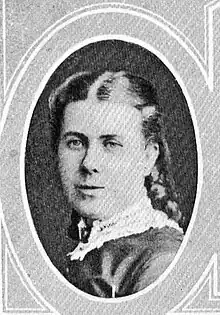Grace Stott | |
|---|---|
 | |
| Born | Grace Cigie 12 March 1845 prob. Scotland |
| Died | 24 January 1922 (aged 76) |
| Nationality | United Kingdom of Great Britain and Ireland |
| Occupation | Missionary |
| Employer | China Inland Mission |
| Known for | long service in China founding schools |
| Spouse | George Stott |
Grace Stott born Grace Cigie (12 March 1845 – 24 January 1922) was a British Protestant missionary in China. She went to China after a marriage proposal arrived in the post. She worked in Wenzhou where she created a school for girls. Her husband George Stott died in 1899. She then returned to China. The mission was struck by riots twice and a cholera epidemic. She became the head of the mission and finally left the mission in 1909 twenty years after he was sacked and his death. Her husband is credited with the mission's success.
Life
She was born in 1845 and brought up in Glasgow by her grandmother, who died. At sixteen she was an enthusiastic Christian with no home ties. She wanted to be a missionary in China after hearing Hudson Taylor speak in Glasgow. She was accepted to go until she fell ill. When the large Lammermuir Party sailed she was left behind on the dock.[1] The opportunity passed her by and she was moved to establish a more domestic mission to the red light districts of Glasgow.[2] She was busy with this when a letter arrived from a young Scot George Stott who she had met. He proposed marriage to her, by mail, and she accepted.[2] George was unusual as he had been chosen as a China Inland Mission (i.e. non denominational) missionary despite having lost a leg. He had planned to take another woman to China as his wife, but her parents disapproved of her going to China.

She travelled out to China arriving in Shanghai in 1870 on her birthday. They were married. They worked together as a team in China. George had created a boys school which contained some converts and some aspiring evangelists. Grace realised that they would have no Christian wives to marry so she created a girls' school in 1875.[2]
There was a lot of resistance to foreign missionaries. On 4 October 1884 the various missions in Wenzhou were completely destroyed by rioters. Her husband was there and he was lucky to get away.[3] Another source says that although wife and his followers learnt to handle his manner which could be direct. He increasingly came into conflict with Hudson Taylor and he had offered to resign in a protest letter. The CIM stopped sending recruits to his station and eventually they "let him go".[4]
George had cancer and they returned to Scotland. George died in 1879 in Cannes where they had gone as a guest of a supporter of their work.[2] She returned to Wenzhou arriving in the following February where she was welcomed. She was now the de facto head of the mission and of the schools and she was there until 1895 when she left due to further riots. An escape as her colleagues died in a cholera epidemic.[2]
Whilst away from the mission she finished and published her biography, "26 years missionary work in China", in 1897[5] After the publication she returned again to Wenzhou until she retired in 1907.
Legacy
Wenzhou is known in China as the “Jerusalem of the East” because in the entire Wenzhou Municipality, which has 6 million inhabitants, there are more than 600,000 evangelical Protestants – 10% of the population.[6] Although Grace Stott worked with her husband and led the mission for twenty years after his death it is her husband and William Edward Soothill who are credited for creating the basis for the large number of Christian adherents in Wenzhou today.[6]
References
- ↑ Austin (2007-03-05). China's Millions. Wm. B. Eerdmans Publishing. p. 108. ISBN 978-0-8028-2975-7.
- 1 2 3 4 5 6 "Stott, Grace (1845–1922), missionary and writer". Oxford Dictionary of National Biography (online ed.). Oxford University Press. 2004. doi:10.1093/ref:odnb/49395. Retrieved 2020-07-30. (Subscription or UK public library membership required.)
- ↑ "Riot at Wenchow". Sydney Morning Herald (NSW : 1842 - 1954). 1884-11-18. p. 5. Retrieved 2020-07-30.
- ↑ Austin (2007-03-05). China's Millions. Wm. B. Eerdmans Publishing. p. 235. ISBN 978-0-8028-2975-7.
- ↑ Stott, Grace; Taylor, James Hudson (2018-02-08). Twenty-Six Years of Missionary Work in China. Creative Media Partners, LLC. ISBN 978-1-377-06528-1.
- 1 2 Anderlini, Jamil (7 November 2014). "The Rise of Christianity in China". Financial Times. Retrieved 13 November 2014.
Further reading
- “Twenty-Six Years of Missionary Work In China” by Grace Ciggie Stott; 1898
- Historical Bibliography of the China Inland Mission
- List of China Inland Mission missionaries in China
- Biographical Dictionary of Chinese Christianity